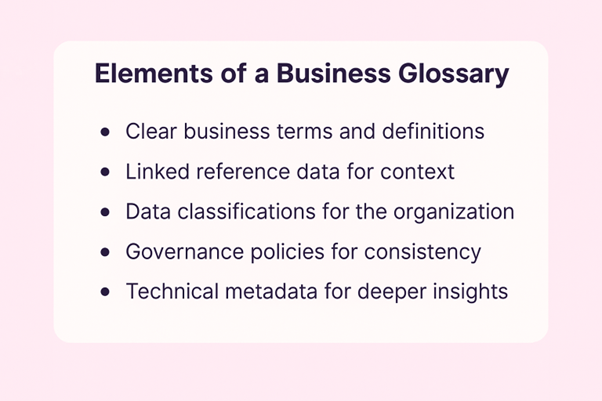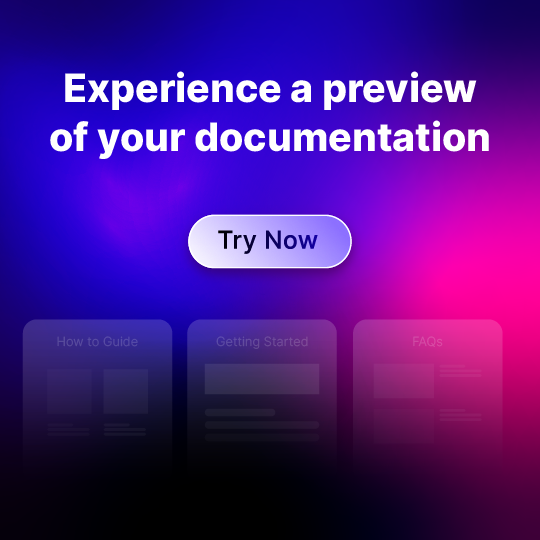Are you struggling with data inconsistency, cross-team collaboration, and delay in decision making? Do you want to implement business glossary management to overcome all these issues?
Whether you are a small or a big organization, things become difficult when teams and stakeholders don’t speak and understand the same business language. There is no understanding and collaboration between different departments, people struggle with business terminology, and innovation is out the window.
This is where a well-managed business glossary comes to your rescue.
In this article, we will explore it from all angles, starting with its definition, its elements, how and why it is important for your business, and the best practices for business glossary management.
So, without any further delay, let’s get started!
What Is a Business Glossary?
A business glossary is an alphabetical list of industry-specific technical and business terms essential to managing and using data, and their definitions. These terms can range from jargon and acronyms to terms related to business processes, products, and concepts.
It helps teams and consumers easily understand these terms in the business context, making the content more informative and user-friendly.
For instance, a knowledge management business glossary will include terms such as:
- Authoring
- Breadcrumb
- Context-sensitive help
- DITA (Darwin Information Typing Architecture)
- End-user documentation, etc.
Each term is defined in the specific context of the knowledge management sector, rendering clarity and consistency for internal teams as well as customers and other stakeholders.
Let us take a closer look at the elements of a business glossary.
What are the Elements of a Business Glossary?
In this section, we will cover the key elements needed to create an effective business glossary for any business or organization.

Clear business terms and definitions
A business glossary consists of industry-specific technical and business terms, ranging from jargon and acronyms to terms related to business processes, products, and concepts.
Clear, concise, and relevant definitions of these terms form the other half of the basic elements of the glossary, completing its purpose.
Linked reference data for context
Reference data is used to define and classify other data and is another important element of a business glossary.
Reference helps provide context to data, affecting its quality and usability throughout the organization. So, selected terms are linked to specific data systems or fields in the business glossary, giving information about how the term is used in the company’s systems and reports.
Data classifications for the organization
Another important element of a business glossary is data classification, where data is classified or organized into categories by business concepts.
Data classification identifies common qualities among data terms and groups them so users can discover the relationships between the data and use it accordingly.
Governance policies for consistency
Governance policies often make up an important element of a business glossary to ensure a common legal understanding around the operations of a business.
For example, clarifying terms such as ‘trade regulations’ and ‘environmental impact’ is crucial to ensure everyone in a business is on the same page regarding the government policies in their business.
Technical metadata for deeper insights
In technical businesses, the business glossary also includes metadata terms for deeper insights. Popularly called ‘data about data’, Metadata is a structured summary, whether active or static, about a particular information or data that makes it easier to find, use, and manage.
For example, author, date created, type of file, etc., providing context to data assets such as a dataset.
🎥 Check out how glossary management is automated with the AI Glossary Generator:
The Importance of Business Glossary Management
Promotes clear and consistent communication
With all its elements as detailed earlier in this article, a business glossary constitutes a common business language. This facilitates communication in various ways.
With a glossary in the knowledge base, all stakeholders can quickly and easily find definitions for specific terms they encounter during their work. It is also the source through which stakeholders can understand data sets and utilize them more effectively.
A business glossary also helps all employees, whether newly recruited or old, understand what is being said in the same context and communicate with clarity in return.
Reduces errors and improves productivity
With the business glossary, all stakeholders have a common understanding of business and technical terms without struggling with them or asking around. This, in turn, saves time on both ends, new and old employees avoid misunderstandings, and allows teams to focus on their core tasks and responsibilities.
Also, since business rules and policies are clearly defined in the business glossary, it acts as a tool for risk management and minimizing errors.
Enhances collaboration between departments
Different teams may use very technical and team-specific terminology that can become a barrier to other teams. For example, finance terminology may be completely alien to a technical team and vice versa.
But since all existing teams have the business glossary to go to, it renders a common understanding of the terms used in the business and facilitates smooth collaboration between teams.
Builds trust in data across the organization
All the teams depend on data for further innovation, but they only use it when it is trustworthy. Data full of conflicting terms and information is of no use and is avoided by teams as it is confusing.
For example, if the finance team wants to use data for better budgeting and forecasting, they need standardized data sets around internal financial records, external market research, and historical data. Unless the information they need is clearly defined, they can neither trust it nor use it.
A well-maintained business glossary eliminates this problem and drives innovation.
Speeds up decision-making with easier data access
With data easily available through an efficiently maintained business glossary, teams can access it as and when required, thereby expediting the decision-making process.
Nobody depends on anyone else to access data, which gives a sense of freedom and allows one to feel restrained when making decisions.
Best Practices for Business Glossary Development
Involve all departments in glossary creation
Research is the first step in creating a comprehensive business glossary that includes the full range of terms used in your business domain and industry.
The best way to ensure this happens is to involve all departments in creating a business glossary. Each department can give a list of terms that must be included in the glossary, and this gives you an exhaustive list for the business glossary you can start with.
Define clear, consistent business terms
Once you have the business terms, you must start defining them as clearly and briefly as possible. It is important to keep the definitions as easy to understand as possible, as the glossary is to be used across the organization at all levels.
Also, the definitions must be consistent for overlapping or interconnected terms.
Align business and IT teams on terminology
It is common for IT teams to feel like a separate silo within a business due to lack of communication and common understanding of terms with other departments.
To avoid this, identify conflicts in how words or terms are used in a business and within the IT team and agree on a common meaning in the future. This can also be true for other departments, and therefore, all conflicting definitions within an organization must be resolved to a common definition.
Keep the glossary updated as the business evolves
To keep the glossary relevant, you must also have a plan to update it as the business evolves, the industry or domain changes, and innovations occur.
Consider using business glossary management tools
Last but not least, investing in tools like Document360, capable of AI glossary management, can pay off. These tools are powerhouses that handle a significant portion of the entire glossary management process for you.
A complete solution within themselves, such tools come with an inbuilt AI glossary generator, glossary support for manual and automatic management, and automatic glossary updation features.
From Chaos to Clarity: What Business Glossary Management Delivers
This article explored the role of business glossaries and outlined practical strategies for building and managing them effectively. By applying these best practices, organizations can foster clearer communication, reduce errors, enhance collaboration, and ensure consistent understanding of data across all teams, laying the groundwork for smoother innovation and confident decision-making.




 –
– 

